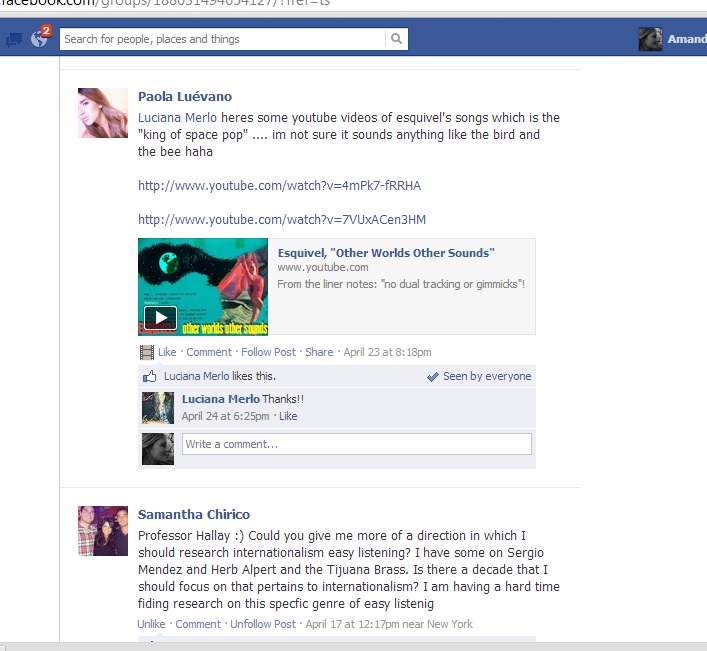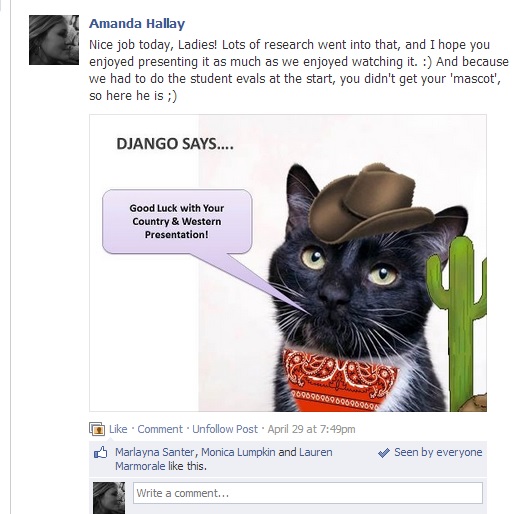 Most of us teachers spend far too much class time suspiciously watching for kids sneaking glances at their Facebook on their phones. So, it might seem odd that I am writing a blog about the virtues of social media as a teaching tool. Yet for the past three semesters, I have been using Facebook Groups as a tool in my Pop Century: A History of Popular Music course. For their Final Project, the class divides into groups and teaches an entire class on an assigned genre of music. It is a huge project that involves a lot of research, music sourcing, and--most of all--communication--between the group members.
Most of us teachers spend far too much class time suspiciously watching for kids sneaking glances at their Facebook on their phones. So, it might seem odd that I am writing a blog about the virtues of social media as a teaching tool. Yet for the past three semesters, I have been using Facebook Groups as a tool in my Pop Century: A History of Popular Music course. For their Final Project, the class divides into groups and teaches an entire class on an assigned genre of music. It is a huge project that involves a lot of research, music sourcing, and--most of all--communication--between the group members.
In past classes when group work has been assigned, I have sometimes felt more like a referee than a teacher. Members blame each other for a less than brilliant project. “She never answered my emails,” “He didn’t send his work through,” “She couldn’t come to the group meetings because of her internship” were just some of the cri du coeurs I’d hear on the day that the projects were due. So, I decided to do things differently in Pop Century because so much of a student’s Final Grade in that class is a result of how well they did on the final project.

Above: Lauren and Marlyana of The Country & Western Group help each other pick the various aspects of the genre to cover.
I wanted to create a ‘venue’ where students could easily communicate with each other, where it would be easy for them to post articles and links, and where I could supervise their progress, give them suggestions, and keep them on the right track (and see which students were doing the most work and which were slacking off). As every single student in Pop Century has a Facebook account, I instructed every group to create a Facebook Group for their genre.

Paola leaves a clip for Luciana (both were in this semester’s Easy Listening and Lounge Group), while Samantha asks me for some guidance.
The results were a great success. Students may ignore email messages from LIM College, but they positively live on Facebook. Updates, questions or suggestions about their presentations are seen and responded to almost immediately. Moreover, if I’m fooling around on the Internet and find a clip or article that might be useful to a group, it is far easier for me to simply leave it on the Facebook Group page, especially if I’m out and about and operating from my phone or tablet.
Knowing they are being watched, Big Brother style, by their instructor, encourages every group member to actively participate, as well as allowing the students in each group to get to know each other in a familiar setting. I have noticed that many of the students go on to add each other as friends on Facebook after working together on their group page.
From a teacher’s point of view, the Facebook Groups are a wonderful way to stay on top of students’ work, give guidance and encouragement, and avoid the “He Said, She Said” Syndrome oft associated with major group projects!
For any of my fellow profs out there tasked with substantial group projects, consider Social Media. To join a Facebook Group, you don’t have to add its members as friends (our lives are our own, after all). But it really has proven to be a wonderful teaching took; it turns Facebook into Workbook, and in such a way that students don’t even realize they’ve just spent two hours online chatting about their group presentation.
And of course, as it’s Facebook, there is always room for a little fun, too!

Amanda Hallay is a full-time professor at LIM College where she teaches courses that concentrate on the relationship between fashion, history and culture. She is a firm believer that the Internet is a wonderful, wonderful thing.
Topics: Facebook, group work, pop culture, Social Media in Teaching, Online cats